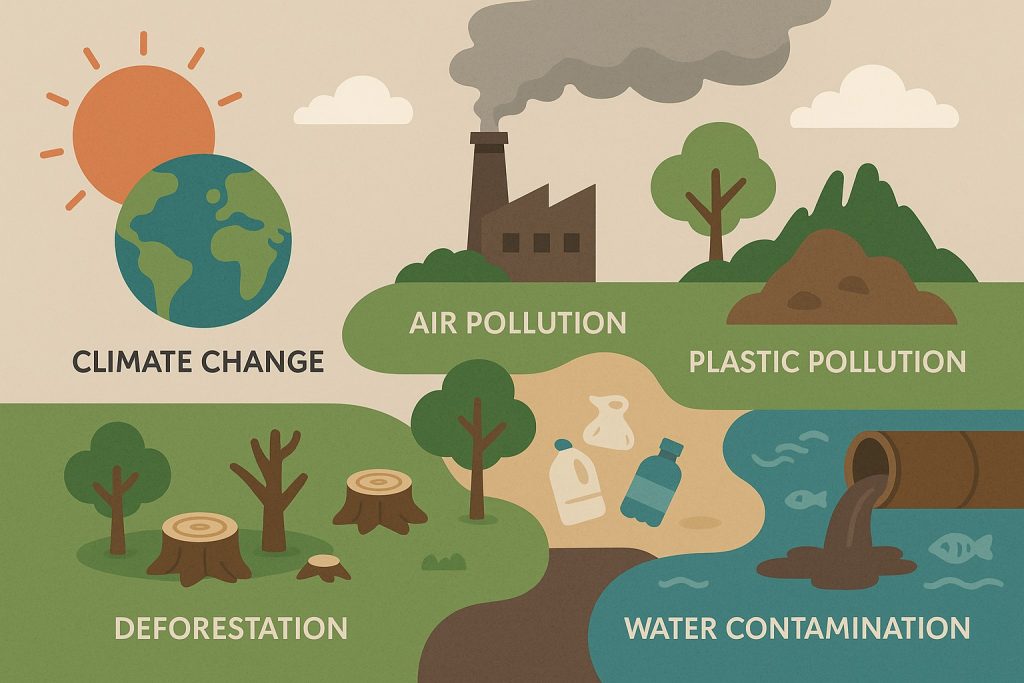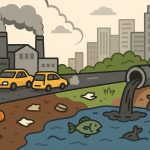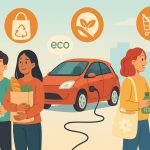In the 21st century, humanity faces a series of urgent environmental crises that threaten the stability of ecosystems, human health, and global security. While technological progress has improved many aspects of life, it has also accelerated resource depletion, pollution, and climate change. This article outlines the major environmental problems of today, their causes, and what can be done to address them.
1. Climate Change
Climate change is one of the most pressing and wide-reaching environmental issues. Driven by the release of greenhouse gases (especially CO₂ and methane), it causes:
- Rising global temperatures
- Melting glaciers and sea-level rise
- More frequent and intense heatwaves, floods, and storms
- Shifts in weather patterns, leading to droughts and crop failures
Main causes:
- Fossil fuel combustion (coal, oil, gas)
- Deforestation
- Industrial agriculture
- Transport and energy sectors
2. Air Pollution
Air pollution is responsible for millions of premature deaths each year. Harmful pollutants include particulate matter (PM2.5), ozone, nitrogen dioxide, and sulfur dioxide.
Effects:
- Respiratory and cardiovascular diseases
- Reduced crop yields
- Acid rain that damages forests and buildings
- Contribution to climate change
3. Water Pollution
Clean freshwater is becoming scarce in many regions. Rivers, lakes, and oceans are polluted by:
- Industrial waste
- Plastic and microplastics
- Agricultural runoff (fertilizers, pesticides)
- Untreated sewage
Consequences:
- Destruction of aquatic life
- Unsafe drinking water
- Spread of waterborne diseases
- Loss of biodiversity in marine ecosystems
4. Loss of Biodiversity
Earth is experiencing a mass extinction event due to human activities. Every year, thousands of plant and animal species vanish, often without being studied.
Major threats:
- Habitat destruction (urbanization, deforestation)
- Poaching and illegal wildlife trade
- Pollution and climate change
- Invasive species
Biodiversity loss weakens ecosystems and reduces their ability to provide food, clean water, and climate regulation.
5. Deforestation
Forests are being cleared at alarming rates, particularly in the Amazon, Southeast Asia, and Central Africa. Trees are cut for:
- Agriculture (soy, palm oil, cattle)
- Timber and paper production
- Mining and infrastructure development
Impacts:
- Increased carbon emissions
- Loss of habitats and species
- Soil erosion and water cycle disruption
- Displacement of Indigenous communities
6. Soil Degradation
Modern farming techniques, deforestation, and industrial pollution have degraded large areas of arable land.
Consequences:
- Reduced agricultural productivity
- Increased desertification
- Threats to food security
- Disrupted carbon storage
7. Waste and Plastic Pollution
The planet is drowning in waste — especially non-biodegradable plastic. Most plastic ends up in landfills or the ocean, where it harms wildlife and enters the food chain.
Problems:
- Oceanic “garbage patches”
- Microplastics in water and food
- Overloaded landfills and toxic leachate
- Slow decomposition (hundreds of years)
8. Overconsumption and Resource Depletion
Modern lifestyles, especially in industrialized countries, demand vast amounts of resources:
- Fossil fuels
- Water
- Minerals and metals
- Timber and food
This overuse is unsustainable and threatens future generations.
What Can Be Done?
Governments and Industry
- Enact and enforce environmental regulations
- Transition to renewable energy
- Protect natural habitats and endangered species
- Promote circular economy models
Individuals
- Reduce, reuse, and recycle
- Support sustainable products and companies
- Conserve energy and water
- Raise awareness and participate in environmental campaigns
Conclusion
Modern environmental issues are complex and interconnected, but not hopeless. With global cooperation, innovation, and responsible action, humanity can reverse many harmful trends. The time to act is now — not just to protect nature, but to preserve the conditions for life itself.
Glossary
- Greenhouse gases – gases that trap heat in Earth’s atmosphere, causing global warming
- Particulate matter (PM2.5) – tiny particles in the air that can harm human health
- Biodiversity – the variety of plant, animal, and microbial life on Earth
- Circular economy – an economic system focused on minimizing waste and reusing materials
- Deforestation – the clearing of forests for agriculture, logging, or development
Suggested Categories
- Environmental Challenges
- Global Sustainability
- Climate and Nature
- Pollution and Conservation


